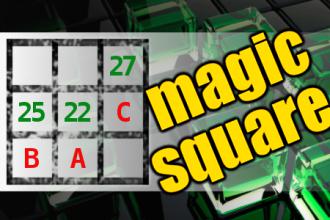MAGIC SQUARE: Calculate A+B+C
The aim is to place the some numbers from the list (9, 19, 20, 21, 22, 25, 27, 37, 38, 43) into the empty squares and squares marked with A, B an C. Sum of each row and column should be equal. All the numbers of the magic square must be different. Find values for A, B, and C. Solution is A+B+C.
Lady trying to catch a ride
A woman comes home early, and finds her husband in bed with a girl.
She is furious, threatens to kill them both... the husband says:
- Believe me, darling, this is just a misunderstanding. I was driving home, and saw this young lady trying to catch a ride. So I decided to give her a lift. I ask her where she needs to go, and she tells me she wants to visit some relatives, but isn't sure about their address. So, I took her home so she could check our phonebook.
- Once there, I saw her dress is pretty ragged, so I decided to give her your old dress. Nearly two years that it's been hanging in the closet, and you never wore it.
- Then, I saw her shoes are also about to fall apart, so I gave her your old shoes, which have been doing nothing but collecting dust for three years. Of course, she said thanks, and then asked:
"Excuse me sir, but is there anything else in this house your wife never uses?"

